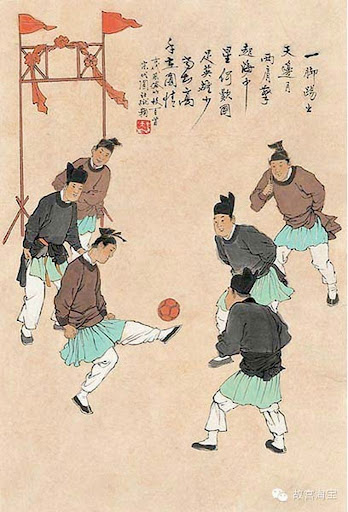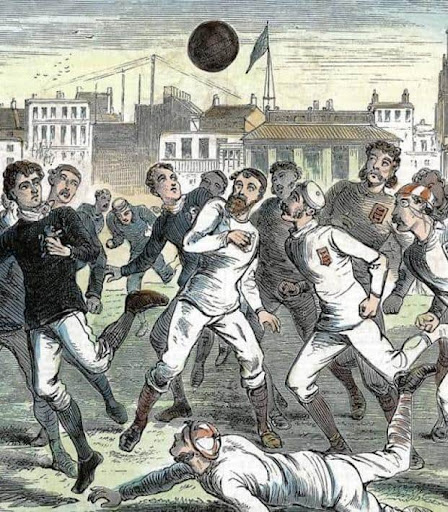When Was Soccer Invented? A Journey Through History
Versions of it can be traced back to ancient China, Greece, Rome, and parts of Central America. But when exactly was soccer invented? Read this article to find the answer to this age-old question.
Soccer, known as football in a majority of countries, is the most popular sport nowadays. It is estimated that more than 250 million people in more than 200 countries play soccer. Being a dynamic and relatively simple game to understand and play may be the main reason for soccer’s popularity.
Soccer, however, didn’t become popular overnight. Its origins stretch back to ancient times, up to around 3000 BC by some accounts. Read on to learn various interesting facts about the beginnings of soccer, the first clubs, how the game developed into its present form, and more.
The Earliest History of Soccer

Modern soccer was invented in England in the 19th century, but the game’s origins started with different sets of rules in ancient China, Greece, Rome, and South America. So let’s look into how these rules differed across these ancient cultures.
Ancient Greece
According to some accounts, a game resembling modern soccer was played as early as 2500 BC in ancient Greece. The game’s name was Episkyros, and it involved two teams trying to score by getting the ball behind the white line on the opposing team’s side of the field. Players used hands in addition to feet in this fairly physical game, which required considerable defense skills.
Ancient China
Certain historical evidence places the invention of soccer in China between the 2nd and 3rd centuries BC, during the Han dynasty. Back then, a competitive game called Tsu Chu, meaning “kicking the ball,” involved kicking a leather ball filled with feathers and hair.
Unlike in ancient Greece, using hands was prohibited, while players could handle the ball with their shoulders, chest, and back.

Players play Tsu Cu, an ancient forerunner of soccer in China (Credit)
The opposing teams played the game on a rectangular field where the objective was to kick a 35-centimeter wide leather ball into a goal – a net created from extended bamboo canes. The net’s elevation at 30 feet from the ground is one way Tsu Chu differed greatly from modern-day soccer.
The Roman Empire
And how did soccer start in ancient Rome? Romans appear to have developed Harpastum, as they called it, from the ancient Greek Episkyros. The game was played with a small ball similar to softball and was quite violent, requiring high skill and swiftness.
Aside from these facts, other details about this ancient ball game remain shrouded in mystery. Due to the Roman Empire’s large territorial expanse, Harpastum was likely played in what is today’s England, with some sources seeing it as an early predecessor of modern soccer.
Soccer Origins in Central America
Existing evidence indicates that an early form of modern soccer was popular in Mesoamerica as early as 3200 BC. Mayans and Aztecs played ball games they called Pok a Tok and Tlachtli, respectively, for religious rather than recreational purposes. As a result, the captain of the losing team was sacrificed, according to some sources.
The playing field of this game was I-shaped, and players had to score by getting the rubber ball resembling the sun to the opposing team’s end of the court. The curiosity was that they had to keep the ball off the ground without using their hands.
Soccer History in the Middle Ages (England and Scotland)
The direct predecessor of modern-day soccer was played throughout the medieval period. Its popularity grew over time, and the game was even banned in England and Scotland at some point.
In Henry IV’s England, royalty wasn’t fond of the game, so a decree was issued to ban this early version of soccer. King James I forbade the game in Scotland since he considered it too disruptive.
Despite the bans, however, the subjects continued playing the game until the 19th century.
Modern Soccer Beginnings
In the 19th century, playing soccer gained momentum among the general populace in England. The game was trendy among schoolers and university students. Yet, the rules differed among public schools, which presented a problem when soccer clubs from different places met to compete against each other.

Soccer in the 19th-century England (Credit)
Suffice it to say that a soccer match resembled a mixture of today’s rugby and soccer. The reason was that the game was predominantly played in two schools – Rugby and Eton. The former school allowed the use of hands, while the latter didn’t, and these games were known as “the running game” in Rugby and “the dribbling game” in Eton.
Cambridge Rules of 1848 – the First Soccer Rules
To resolve the differences and develop a set of rules, teachers from various schools in southern England met at Cambridge in 1848. They agreed to ban the use of hands and for soccer players of the same team to wear identical colors, among other rules. This laid the foundation of soccer as we now know it.
However, various schools from northern England continued playing according to their own rules.
The Sheffield Rules of 1858
In 1858, representatives of football clubs from northern England met in Sheffield to establish a set of rules that would apply to all teams. They introduced the foul, offside, and throw-in concepts, among others. Still, certain fine-tuning remained to be done in the following years since handling the ball wasn’t banned entirely.
The Football Association (FA) Founded in 1863
Now that we know the answer to the question: “When was soccer invented?” let’s see how the rules became binding for all clubs.
To reach a nationwide agreement about soccer rules, club and school representatives created the Football Association. Football rules weren’t established immediately since various representatives walked away from negotiations because they deemed proposals unacceptable. Some disputes concerned whether handling the soccer ball should be allowed or not.
That’s how rugby and soccer definitely parted ways.
On December 19, 1863, Barnes Football Club and Richmond Football Club played the first soccer match under the newly established Football Association rules. Each team had 15 players, and no disputes about the rules arose, which was quite surprising at the time. Barnes had six attempts to score but failed every time, so the game was declared a draw after 90 minutes of play.
On March 31, 1866, Sheffield and a representative London club played the first game under the new FA rules, and some of them were:
- The field had to be 120 by 80 yards wide.
- The teams had to be played eleven a side.
- The teams had to play the soccer match between 3 pm and 4:30 pm.
Soccer Becoming a Global Phenomenon
With its rising popularity in England, a colonial superpower in the 19th century, soccer started spreading to other countries. Sailors, soldiers, merchants, and other travelers introduced the game to different parts of the world. Interest in soccer increased remarkably quickly in India and South America.
The First Modern Soccer Clubs
While teams playing soccer existed in the past, the first soccer clubs were formed in the 19th century as the popularity of the most popular game today gained momentum.
Some sources indicate that Edinburgh, Scotland, was home to the first football club in 1824. Still, various historians point out that students formed a soccer club in Sheffield, England, in 1855. Notts County, founded in 1862, is claimed to be the oldest soccer club.
Famous rivalries originated down the line, leading to the phenomenon we now know as derby. Many countries have highly anticipated soccer derbies, and England, Argentina, Italy, and Turkey are some of them.
The Popularity of Soccer Grows
When soccer was invented, it first had the most fans among school and university students. Then industrialization and the spread of factories and railways increased the fan base among the working-class population.
At the same time, large cities started founding clubs, and teams began to pay outstanding players to join their ranks. In 1893, Derby County suggested that the player’s maximum weekly wage in the Football League shouldn’t exceed £4. In 2022, Lionel Messi ($130 million annually) and Christiano Ronaldo ($115 million per year) are among the best-paid soccer players in the world.
Foundation of the First League
The growing interest in this beautiful game led to the foundation of the Football League, the first professional football (soccer) league, in 1885. By then, clubs had already charged tickets for attendance.
Twelve clubs joined the league during the introductory season, but many clubs signed up quickly thereafter, which led to the establishment of more divisions.
British teams held a strong grip over the sport for many years. Eventually, teams from cities like Prague, Budapest, and Sienna started challenging them.
International Matches Between Two National Teams
The Football Association Challenge Cup (FA Cup) became the first significant soccer competition, and the first match played between national teams, England and Scotland, took place on November 30, 1872, in Glasgow, Scotland. The final score was 0:0, and the attendance was at 4,000.
The first international soccer tournament, known as the British Home Championship, was organized in 1883, played by England, Ireland, Scotland, and Wales. Scotland won the tournament by defeating each opponent. England took the second position, Whales was third, and Ireland ended last.
The foundation of the Fédération Internationale de Football Association (FIFA) followed in 1904. British national teams joined the following year but refrained from playing the FIFA World Cup until 1950.
In the meantime, football became an Olympic sport and was played at the Olympic games in 1908.
The first World Cup took place in 1930 in Uruguay, with 13 national teams competing for the first soccer world championship title. The host country won the title by defeating Argentina 4:2 in the final game, with a total attendance, according to some accounts, over 90,000. The USA was third, while Yugoslavia ended up fourth.
Despite this early success, soccer had to wait another 60-plus years to gain prominence in the USA. The foundation of Major League Soccer, the most prominent men’s professional league gathering American and Canadian teams, ensued after the USA hosted the 1994 World Cup, and the first game took place in 1996.
Final Words
The game has a long and rich history, with various countries claiming to be the home of soccer and providing strong evidence to boot.
Still, today’s soccer features elements from its distant predecessors from ancient Greece, China, and Mesoamerica. So, it would be fair to say that soccer is a product of many cultures united by the love of the game.
It’s impossible to know for sure who the inventor of soccer was, but it’s clear that the game has been around since ancient times. As such, it has captured the hearts of people all over the world and will continue to do so for many years to come.
The popularity of modern soccer has grown exponentially over the years. What started as a game played by school and university students has become a global phenomenon. The result is that, nowadays, hundreds of millions of people across the world play, and many more watch the game.
FAQ
Where was soccer invented?
It’s impossible to precisely answer the question since this sport has roots in ancient Greece, China, and other countries. Still, the beginnings of modern soccer can be traced to 19th-century England.
How old is soccer?
Soccer has roots in ancient civilizations that existed thousands of years BC. Still, the foundations of modern soccer were established around the mid-19th century in England.
Who invented soccer in England?
We can’t credit anyone in particular for inventing the game in England. Still, Ebenezer Morley is often considered the father of the Football Association. To learn more about the beginnings of soccer in ancient times and 19th-century England, check out PlayToday’s “When Was Soccer Invented?” article.
 BC.Game
BC.Game  BitStarz
BitStarz  Ducky Luck
Ducky Luck  Red Dog Casino
Red Dog Casino